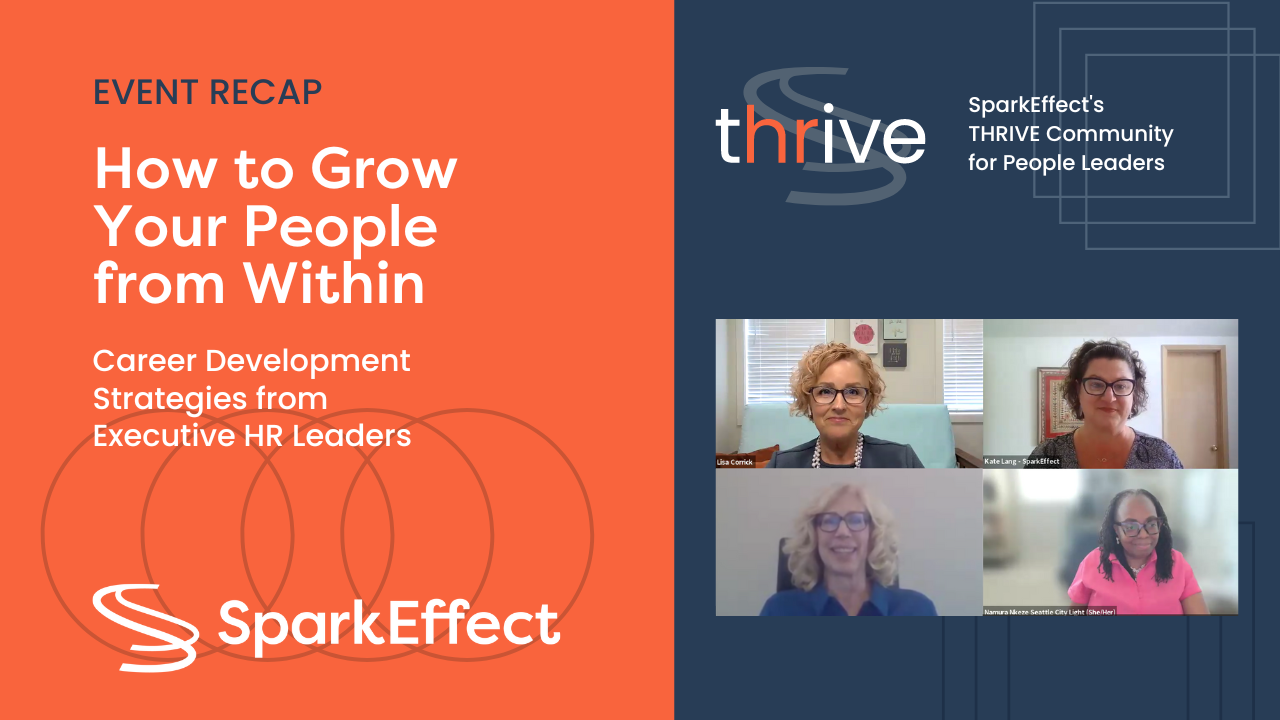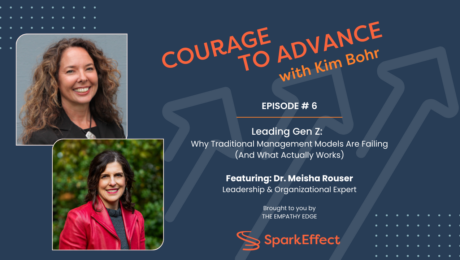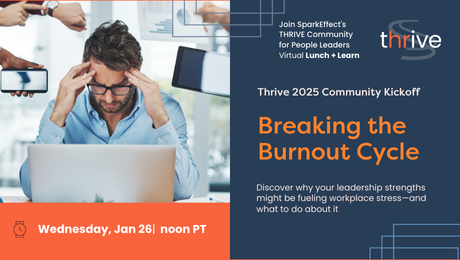Key Takeaways from SparkEffect's Thrive Webinar “How to Grow Your People from Within”
At SparkEffect, we’re passionate about helping organizations and their people reach their full potential. That’s why we were thrilled to host our recent Thrive webinar on “Growing People from Within: Strategies for Effective Career Development Programs.” Moderated by Kate Lang, SparkEffect’s experienced career coach and organizational development expert, the session brought together a panel of HR and talent development leaders for an insightful discussion.
Watch the Full Webinar
Missed the live event or want the further insights shared? Watch the full “Growing People from Within” Thrive webinar recording to hear our expert panel dive deep into effective career development strategies.
Our expert panel, featuring HR and talent development leaders from diverse industries, shared invaluable insights on creating, implementing, and sustaining impactful career development initiatives. Here are some key takeaways for HR and talent leaders looking to start or enhance their organization’s career development efforts:
1. Start with the “Why” and Get Buy-In
Before launching any career development program, it’s crucial to link it to organizational values and business needs. As Lisa Corrick, career & talent development coach, shared her successful diversity-focused career program gained traction because it addressed a clear organizational goal: growing diverse representation at mid and senior levels.
To achieve both philosophical and financial buy-in:
-
- Connect your initiative to company values and strategic objectives
-
- Leverage data to demonstrate the business case
-
- Engage key stakeholders early, including executives and HR business partners
-
- Start small with pilot programs to prove value before scaling
2. Make It Accessible and Inclusive
Traditional nomination-based programs can perpetuate bias and limit opportunities. Our panelists advocated for more open, inclusive approaches:
-
- Allow employees to self-nominate or apply for development programs
-
- Leverage technology to reach remote workers (e.g., virtual coaching platforms)
-
- Offer development opportunities across levels, from interns to executives
-
- Provide a mix of group learning and individualized support
3. Engage Leaders as Sponsors and Coaches
Executive involvement is key to program success and organizational buy-in. Jackie McCormick, former chief people and culture officer,shared how her mentorship program engaged executives as project sponsors, while Lisa’s initiative paired participants with executive sponsors.
Tips for leader engagement:
-
- Make the time commitment manageable (e.g., 1 hour per month)
-
- Provide structure and discussion guides, while allowing flexibility
-
- Demonstrate the impact through participant presentations and success stories
4. Focus on Continuous Development, Not Just Promotions
Career development isn’t just about climbing the ladder. It’s about helping employees grow and add value wherever they are. As Lisa noted, “You don’t need to want to go somewhere else, but we do want you to want to better yourself, whatever that looks like.”
Encourage development plans for all employees, focusing on:
-
- Skill enhancement in current roles
-
- Cross-functional knowledge building
-
- Preparing for future organizational needs
-
- Legacy planning and knowledge transfer
5. Leverage Technology and Peer Learning
Namura Nkeze, employee experience manager, shared the success of implementing a peer coaching platform, which allowed her organization to scale coaching efforts cost-effectively. Consider how technology can help you:
-
- Connect employees for peer mentoring and knowledge sharing
-
- Provide on-demand learning resources
-
- Track engagement and measure program impact
6. Start Early and Make It Ongoing
Career development should begin from day one and continue throughout the employee lifecycle. Namura emphasized focusing on the first year, particularly during onboarding, to drive engagement and retention. Jackie highlighted the importance of regular career conversations as part of the performance management process.
7. Measure Impact and Iterate
Use data to guide your efforts and demonstrate ROI. Key metrics might include:
-
- Promotion rates for program participants
-
- Employee engagement scores
-
- Retention rates
-
- Time to fill internal positions
-
- Manager effectiveness in developing teams
Remember to gather both quantitative and qualitative feedback to continuously improve your programs.
Embarking on Your Career Development Journey
Creating a culture of continuous learning and growth takes time, but the payoff in terms of engagement, retention, and organizational capability is immense. Start small, focus on quick wins, and build momentum. As you develop your career development strategy, remember that SparkEffect is here to partner with you, offering expertise and tailored solutions to illuminate the path forward for your organization and its people. Ready to take the next step in evolving your career development efforts? Contact SparkEffect today for a free consultation and let’s explore how we can help your organization and employees thrive.
Cultivate Your Organization’s Career Development Prowess
Thrive is SparkEffect’s FREE community for forward-thinking People Leaders passionate about employee growth. Join our virtual gatherings to explore cutting-edge strategies in career development, talent management, and other organizational transformation topics.
Network, brainstorm, and collaborate with HR innovators to:
- Design impactful career development program
- Engage employees at all levels in continuous learning
- Retain top talent through growth opportunities
- Attract high-potential candidates with your commitment to development
Don’t miss our next illuminating session! Sign up now to be part of the Thrive community and receive invitations to future events focused on nurturing your organization’s most valuable asset – your people.






